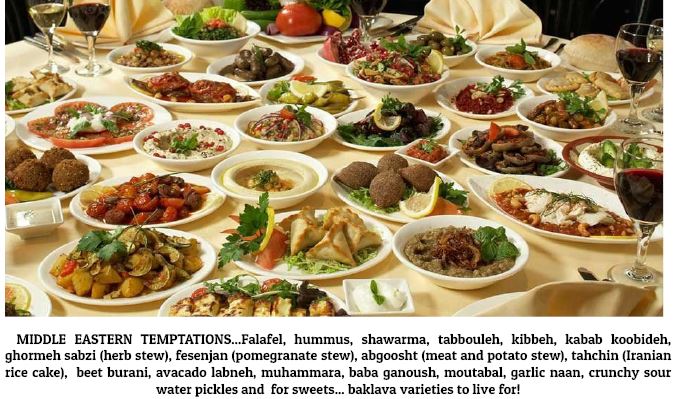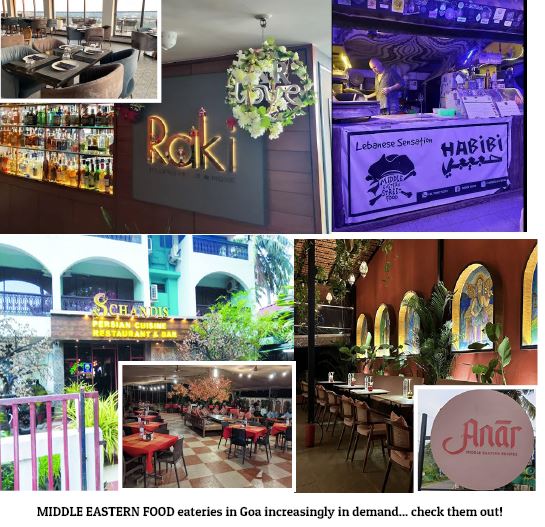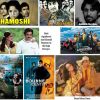Goa is abuzz with excitement as vintage bike and car owners, users, collectors and fans are decking […]

MEDITERRANEAN/LEBANESE/PERSIAN FOOD…BEST!
Eating is Fun / Eating is Yuck! - A variety food column, Life & Living, May 10- May 16, 2025 May 9, 2025By Tara Narayan
MOST folk in the health and wellbeing business swear by it. That Mediterranean is best food of them all to live long and happy! I’m inclined to agree with this and would add on many of the Lebanese and Iranian/Persian dishes alongside and especially what’s called the mezze platter of appetizers which one could very easily make a meal off for an early dinner light meal.
Most of the recipes on a Lebanese mezze platter are so agreeable with their use of fresh veggies, beans and nuts and the use of cous cous or bulgur (fine grain cracked wheat, or semolina ), fresh veggies and fruit salad, beans, nuts and good olive oil (which along with coconut oil enjoys a super oil status along with black cumin oil nowadays but the later is hard to find, this is considered as a real healer from the inside out of most any disease taking a toll on you).
Sea salt or celtic salt or rock salt or black salt are considered the superior salts of life. Amongst non-vegetarian super foods fish tops the list and some say don’t patronize hormone pumped or chemical injected industrial meats of chicken, beef or whatever else. Fresh lamb and goat meats are fine if the hoofed animals are grass fed in pristine open country…then you may arrive at a great lamb pilaf/pulao or biryani which is hard to find except in homes where the cooks are Kashmiri, Persian, Iranian, Turkish or Mediterranean ancestry. Somehow these three cuisines have blended into superlative symbiosis influencing one another through long years of warfare, l trading history and the happy pollination people do.
IN my growing up with food I’ve found some recipes just ring of different cultures of yore…like in Bombay of old or Mumbai of new if you talk of a desire to feast on berry pulao at an Irani restaurant like Brittannia & Company at Ballard Estate, you learn these berries which are sour sweet barberries still arrive from Iran or the Middle East, and of Persian ancestry in foodie matters. Iranian or Persian berry pulao/pilaf is considered a healthier rice dish …a lot depends on who prepares it of course and how faithful it is to original recipes.
The famous berry pulao/pilaf full of sour sweet barberries is sometimes described in Irani/Parsi restaurants offering it on the menu as “Zereshk Polow Persian barberry rice…cooked with onions, orange peels, almonds in a saffron rose sauce.” The barberries one may find stocked with several Middle Eastern grocers along with other popularly used ingredients in cooking such as almonds, pistachios, mixed herb, rose water, rose petals, curd of various denomination.

In fact, rice in the Middle Eastern and Oriental cuisines is seen as wholesome food and there are so many robust varieties, including the most superlative non-glutinous black rice which turns purplish upon cooking, one may today even find jasmine black rice and other types of rice which are almost meaty in aroma…meishi Thai long grain black rice is much sought after. In the Middle Eastern countries rice is cooked so that there is this “tahdig” crunchy bottom which various family members may claim to have first rights over! Buttery, crusty bottom rice is served to guests first or something like that.
Most of these rice varieties don’t have a high glycemic index and so are recommended as fiber-rich nutritious rice to eat in small quantities. They may not be stuffed to the gills as we do with our various white refined rice varieties. But to return to the best of cuisines which is Mediterranean cuisine no less a person than the famous heart doctor Dr Dean Ornish advices a diet which has close affinity with the Mediterranean foods, both emphasizing plant-based foods and healthy fats.
The Ornish diet is a very low-fat vegan-based diet with specific fat limits and strict calorie control, it’s harder to do but it’s said to be very heart-friendly and I need to go for it although I don’t! the Mediterranean and Middle East cuisines are allow good amounts of fish, poultry, eggs and dairy, health fats of olive oil and nuts.
Needless to say if you can swing it do a combo of both Mediterranean and Ornish diet guidelines and benefit all round vis-à-vis cardiovascular and other things to do with weight management (obesity being the single largest reason setting the stage for trouble with major metabolic diseases such as insulin resistance (high carbohydrate diet), diabetes and then kidney and liver failures as the years catch up with us and it becomes harder and harder to get back in time to do the needful at the right time.
Still it is never too late to sit and up and do stock-taking. Do check out both Mediterranean and Dean Ornish advice in books which have made a major impact on those seeking wellbeing with longevity. Mediterranean and some Middle Eastern emphasize on plant and fruit–based foods, healthy fats as in fish, poultry, eggs, dairy but in moderation; the Ornish prescription says less fats than in Mediterranean which allows more flexibility in food choices. But mix and match and both offer the numerous health benefits considered the best!
SO think Mediterranean in all the ways you can along with Middle Eastern, Persian, Turkish…some will say Oriental is best of course; and I will say most basic cuisines are fine until they get messed up with an overwhelming amount of industrial junk foods of today’s ultra modern market place. Mixed Mediterranean and Lebanese eateries are doing well in Goa and perhaps one of these days you may want to catch up with say places with names like Hossein’s “Schandis” and Amit Monserrate’s “Raki Modern Mezze & More” in Panjim. Raki is a terrace restaurant overlooking Miramar beach and winning rave reviews for its presentation of mixed Mediterranean and Middle Eastern fare; my ardent foodie friends Odette and Joe Mascarenhas recently spoke about “hidden treasure” at a place called “Anar” in Anjuna which does a Middle Eastern menu….other places I hear of “Kefi Café & Bistro” (Assagao), “Mezmiz Goa,” “Habibi Labenese Sensation,” “Kiki by the Sea Goa”… “Suqoon Palolem.” I’m astonished and enlightened by the popularity of these Middle Eastern eateries in Goa!
Think awesome chickpea dips like hummus (served in so many different ways), a range of raita-styled or and creamy curd and cheesy dips of spinach, beetroot, aubergine — baba ganoush – along with crispy falafel, pilaf, plain pita chips or crisp hot naan. Mezze is just the word for say Spanish tapas or Italian antipasti, really hors d’oeuvres or a selection of flavorful finger food which may be part of a main meal or serve as a light meal in a class of its own.
More and more one sees the influential touches of Lebanese, Turkish, Middle Eastern, even Arab and French…it’s the generous use of mint, parsley, lemons I love, then za’atar, labneh, haloumi, kofta, kibbey is the national dish of Lebanon and Syria, basically pounded bulgur wheat with meat and then served as aromatic meat balls fried, or grilled. Include even shawarma if you like although some look down on this for some reason, I don’t why, not really healthy. Many of these recipes may find their origins in the kitchens of erstwhile Persia and Sultan Suleiman’s Ottoman empire of Turkish history. It’s not for nothing that Turkey is considered the gateway to Europe.
Okay, this is to say go heal yourself with good food this week and forever after!















